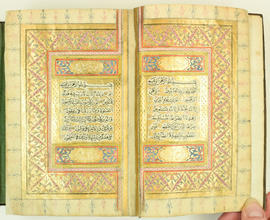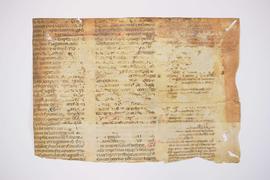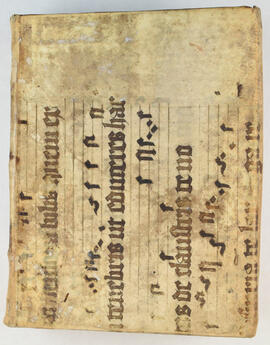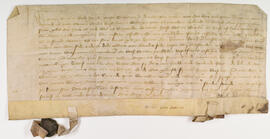Showing 277 results
Archival description182 results with digital objects Show results with digital objects
Antiphonary initial with hand drawn face
- CA MRUASC C0003-S2-0083-14
- Item
- [14--?]
Item is a fragment of a fifteenth century antiphonary leaf, containing a large initial with hand drawn face.
Bible leaf - Interpretationes Hebraicorum Nominum
- CA MRUASC C0003-S4-0102-07
- Item
- [12--]
Item is a leaf from a pocket Bible featuring what is likely a section of the Interpretationes Hebraicorum Nominum (Interpretations of Hebrew Names), an alphabetical list of proper names appearing in the Bible with a short commentary on their meaning, provided as an aid to scriptural study. This section covers I-M.
Bible leaf from William de Brailes' workshop
- CA MRUASC C0003-S4-0102-24
- Item
- [ca. 1240]
Item is a leaf from an English pocket bible containing verses 22:12-24:39 of the Book of Ecclesiastes. Leaf features illuminated initials and marginalia including a partial English translation of verse 24:1 ("Wisedome shall prayse herselfe and be honored in god and rejoyse in the middes of his people :". The leaf was produced in Oxford in the workshop of the prominent manuscript illuminator William de Brailes.
A partial transcription of the leaf reads: Beginning nequissimi enim...: "For the wicked life of a wicked fool is worse than death... keep fidelity with a friend in his poverty, that in his prosperity also thou mayst rejoice... wisdom shall praise her own self, and shall be honored in God, and shall glory in the midst of her people and shall open her mouth in the churches of the most high, and shall glorify herself in the sight of his power... he said to me: let thy dwelling be in Jacob, and thy inheritance in Israel, and take root in my elect. From the beginning and before the world, was I created, and unto the world to come I shall not cease to be, and in the holy dwelling place I have ministered before him..."
Bible leaf from William de Brailes' workshop
- CA MRUASC C0003-S4-0102-16
- Item
- [ca. 1240]
Item is a leaf from an English pocket Bible containing verses 6-8 of the Book of Kings. The leaf was produced in Oxford in the workshop of the prominent illuminator William de Brailes. Leaf features illuminated initials and chapter numbers, crossed-out mistakes, and some marginal notes.
- CA MRUASC C0003-S4
- Series
- [ca. 1240]-[ca. 1275], [18--]
Series consists of leaves from pocket Bibles, and a complete Ethiopian Coptic Bible.
Bifolium from Mondino dei Luzzi's commentary on De Simplicibus by Yuhanna ibn Masawaih
- CA MRUASC C0003-0082-08
- Item
- [13--?]
Item is a bifolium of a medical text that was recovered from a binding where it was used as a pastedown. The bifolium, most likely scribed in Italy, contains portions of a Latin translation of the medical text De Simplicibus (Simples) by the Baghdadi physician Yuhanna ibn Masawaih / Masawaiyh / Mseue (circa 777-857), with commentary by the Italian physician Mondino de Luzzi. De Simplicibus discusses natural ingredients that could be used on their own as laxatives or purgatives; one side covers the following ingredients: wormwood, French lavender, fumitory, hemp, agrimony, and thyme.
Further description provided by Stephen Butler Rare Books & Manuscripts: Each leaf c. 370 × 250 mm, the ruled space c. 210 × 140 mm, in two columns of 49 lines written in Gothic script, paraphs alternately red or blue, underlining in red, each chapter with a rubric in red and a two-line initial alternately red with blue flourishing or vice versa, recovered from use as a pastedown, with consequent holes and staining, especially to one side, but still mostly legible. The more legible side begins in the section De viola (violet): et viole ficce educunt dissolvendo. … and continues with rubrics for chapters 13 [sic] De abscinthio (wormwood), 13 De sticados (French lavender), 14 De fumo terre (fumitory), 15 De eupatorio (hemp agrimony), and 16 De epithemo (thyme), ending at … et pallidum ; the text is printed in Mesue cum expositione Mondini super canones universales (1502), De simplicibus, fol. 35r, col. b, line 26 from the bottom fol. 36r, col. b, line 1 (online through Google Books). The text De simplicibus (Simples) concerns single natural ingredients that could be used on their own as purgatives (laxatives).
- CA MRUASC C0003-S1-0102-10
- Item
- [14--?]
Item is an illuminated leaf, likely from a book of hours. The leaf features initials and line fillers in red, blue, and burnished gold.
- CA MRUASC C0003-S1-0102-15
- Item
- [ca. 1450]
Item is a leaf from a book of hours.
- CA MRUASC C0003-S1-0102-13
- Item
- [14--?]
Item is a very small leaf, likely from a book of hours.
Book of hours leaf [in German?]
- CA MRUASC C0003-S1-0102-12
- Item
- [14--?]
Item is a leaf from a book of hours in a vernacular language, possibly medieval German.
Book of hours leaf with donor portrait
- CA MRUASC C0003-S1-0102-41
- Item
- [1490?]
Item is a full page portrait of the Madonna and child from a book of hours, possibly from France. The portrait also depicts an image of the donor, who is a Cistercian nun on the left hand side, and an unknown saint on the right, who the donor would have been particularly devoted to. Donors portraits became popular from the 13th century on, and were typically meant to convey a donor's devotion and piety down through the ages.
Books of hours and prayer books
- CA MRUASC C0003-S1
- Series
- [12--]-[ca.1460], predominant 1400-1460
Series consists of leaves and a bifolium from books of hours and other Christian devotional texts for the private use of laypeople (non-clergy), which were very popular in the late medieval period.
- CA MRUASC C0003-S2-0102-11
- Item
- [14--?]
Item is a leaf, likely from a breviary, featuring a calendar of church feasts from July to December. A breviary is a liturgical book used by the clergy to celebrate the Divine Office (also known as the Liturgy of the Hours), and contains readings, hymns, psalms, and prayers.
- CA MRUASC C0003-S2-0102-09
- Item
- [14--?]
Item is a leaf, likely from a breviary, featuring illuminated initials in painted gold on brown, blue, or red grounds. A breviary is a liturgical book used by the clergy to celebrate the Divine Office (also known as the Liturgy of the Hours), and contains readings, hymns, psalms, and prayers.
Breviary leaf with heavy rubrication
- CA MRUASC C0003-S2-0102-08
- Item
- [14--?]
Item is a heavily-rubricated leaf from a breviary. A breviary is a liturgical book used by the clergy to celebrate the Divine Office (also known as the Liturgy of the Hours), and contains readings, hymns, psalms, and prayers.
- CA MRUASC C0003-0225-12
- Item
- [between 1880 and 1930]
File contains a leaf from a Burmese black parabaik, or folding-book manuscript, that contains tattoo designs, including: birds, tigers (one eating a person), flags, and an elaborate hti (a Burmese umbrella, an important religious symbol and marker of high social status). Tattooing was a traditional practice of several ethnic groups (including the Shan people) in Burma / Myanmar until the 20th century, and had cultural, religious, and magical significance. The accompanying text is likely in Burmese or Shan.
Parabaik are made of thick paper from the bark of the paper mulberry tree that is sometimes blackened with charcoal like this one, and then written on with a white steatite (soapstone) pencil. The paper is then folded accordion-style and bound with protective covers.
Calendar from a Burgundian breviary
- CA MRUASC C0003-S2-0102-46
- Item
- [ca. 1475]
Item is a complete breviary calendar from the Autun area of Burgundy. Item notes various feasts and religious observances related the saints and figures associated with Autun. Item was cut from a 15th century breviary and reused in a later binding. Item features illuminated initial letters and flowers and gold leaf.
- CA MRUASC C0003-S5
- Series
- [ca. 1300]
Series contains a leaf and fragments of leaves from books of canon (church) and civil law.
- CA MRUASC C0003-NA25-02
- Item
- 1668
Item is a 17th century edition of an account of the nobel lives and deeds of noble Germans, bound in a 15th century medieval manuscript with musical notation.
- CA MRUASC C0003-S3-0225-31
- Item
- July 12, 1445
Item is a medieval charter sanctioning the division of Gilles Dabelain's property between his children, Hues Dabelain and Jehanne, the wife of Jehan de Lannoy. Item was written in a 114-line format in the city of Lille, France. Item contains one intact seal and the fragments of three other seals.
Declaration of the sale of a house in Paris
- CA MRUASC C0003-S3-0086-07
- Item
- August 22, 1342
Item is a French contract regarding the sale of a house in the city of Paris.
Diverses receptes et curieux secrets de medecine pour toutes sorte de maux et maladies ett l'usage
- CA MRUASC C0003-0377-01
- Item
- 1726
Item is an early 18th century manuscript book of medicinal recipes and dubious 'cures'. Some recipes contain fantastical ingredients such as dragon's blood and powdered mummy. Item also includes two colourful prayer cards inserted into the pages. Item has been bound in a recycled antiphonal leaf with four staves of faded musical notation.
Egyptian Coptic Euchologion leaf
- CA MRUASC C0003-S2-0102-37
- Item
- [15--?]
Item is a leaf from a Euchologion, one of the principal liturgical texts of the Coptic churches (as well as the Eastern Orthodox and Byzantine Catholic churches). The text is written in Bohairic (an Egyptian dialect of the Coptic language, and the official liturgical language), with an Arabic translation. The leaf features some rubrication and a marginal illustration of a cross on the verso.
Election of prelates - supplementary readings
- CA MRUASC C0003-S3-0102-45
- Item
- [14--]
Item is a slip of paper originating from northern Germany or the Low Countries, containing supplementary readings to be used during the prelate electoral process. Item contains two red 'pointing hands' that direct the reader to red crosses that were meant to be kissed by the supplicant during the ritual.
- CA MRUASC C0003-S1-0102-26
- Item
- [ca. 1440]
Item is a leaf from an English book of hours containing verses 22:5-23:4 of the Book of Psalms. The leaf may have been produced at Syon Abbey (a wealthy monastery of the Bridgettine Order that was located east of London on the north bank of the River Thames in the parish of Isleworth), but this claim (from the seller's description) remains unsubstantiated. The leaf features illuminated initials of burnished gold and a floral border on the recto. Surviving English books of hours are rare, as many were destroyed during the English Reformation.
A partial transcription of the leaf reads: Beginning with "In conspectus meo..." : "Thou preparest a table before me in the presence of mine enemies: thou anointest my head with oil; my cup runneth over. Surely goodness and mercy shall follow me all the days of my life and I will dwell in the house of the Lord forever."
Beginning with the illuminated letter D of "Domini est terra..." : "The earth is the Lord's and the fullness thereof: the world, and all they that dwell therein. For he hath founded it upon the seas; and hath prepared it upon the rivers. Who shall ascend into the mountains of the Lord: or who shall stand in his holy place? The innocent in hands, and the clean of heart, who hath not taken his soul in vain, nor sworn deceitfully to his neighbour..."
- CA MRUASC C0003-S4-0102-25
- Item
- [between 1250 and 1275]
Item is a leaf from an English pocket bible, possibly from East Anglia, containing verses 10:30-12:41 of the Book of Mark. Leaf features illuminated initials and marginalia.
A partial transcription of the leaf reads: "Et sorores, et matres, et agros..." : "and sisters , and mothers, and children... the Son of man also is not come to be ministered unto, but to minister, and to give his life a redemption for many... Hosanna, blessed is he that cometh in the name of the Lord... My house shall be called the house of prayer to all nations. But you have made it a den of thieves... Render therefore to Caesar the things that are Caesar's and to God the things that are God's... And thou shalt love the Lord thy God, with thy whole heart, and with thy whole soul, and with thy whole mind, and with thy whole strength. This is the first commandment. And the second is like to it; thou shalt love thy neighbor as thyself..."
- CA MRUASC C0003-S2-0102-35-02
- Item
- [13--]
Item is a leaf from an illuminated psalter featuring initials, line fillers, and leafy borders in red, blue, and burnished gold. The borders are inhabited by a pointing figure (recto), and a downward facing human-animal hybrid with a tall hat (verso).
- CA MRUASC C0003-S2-0102-35-01
- Item
- [13--]
Item is a leaf from an illuminated psalter featuring a marginal illustration of a bird, as well as initials, line fillers, and leafy borders in red, blue, and burnished gold.
- CA MRUASC C0003-S2-0102-35
- File
- [13--]
File contains two leaves from an illuminated psalter that feature illuminated initials and line fillers in red, blue, and burnished gold. The leaves also feature three-quarter borders on both sides depicting long tendrils terminating in trefoils and containing marginal illustrations of humans/hybrid creatures and a bird. A psalter is a book containing the Book of Psalms and often other devotional texts such as a liturgical calendar, Litany of Saints, and Office of the Dead.
- CA MRUASC C0003-0357-01
- Item
- [18--]
Item is an Ethiopian healing scroll written in Ge'ez, the liturgical language of the Ethiopian Orthodox Church.
- CA MRUASC C0003-S4-0030-01
- Item
- [18--]
Item is an Ethiopian Coptic manuscript Bible with a mahdar, a leather case to protect the sacred text. The codex consists of 140 goatskin parchment leaves, with text in Ge'ez (the liturgical language of the Ethiopian church) written in red and black ink, with occasional later annotations throughout. The codex is illustrated with 9 full-page miniatures, and 5 decorative headpieces in black, red, and blue. The binding is in traditional Ethiopian Coptic style and features a leather spine covering and wooden boards (the back board has lost a section, but has been repaired with a replacement piece).
Flemish book of hours bifolium
- CA MRUASC C0003-S1-0102-27
- Item
- [ca. 1450]
Item is a continuous bifolium from a book of hours produced in Flanders. The text follows the Use of Sarum (Salisbury), an English variant of the Roman rite for public worship, indicating that it was produced for the English market. The two leaves constituting the bifolium contain the latter part of a Litany of Saints, and feature illuminated initials and burnished gold lettering. A partial transcription of the leaves reads:
Beginning with the illuminated letter "U" ut oculos...: "That it may please thee to look upon us with eyes of mercy... Lamb of God that takest away the sins of the world, spare us O Lord... Lord have mercy upon us. Christ have mercy upon us..."
Beginning with the illuminated letter "D" deus...: "O God, Whose property is always to have mercy and to spare, receive our petition; that we and all thy servants who are bound by the chain of sin may, by the compassion of thy goodness mercifully be absolved..."
Beginning with the illuminated letter "I" in...: "Show with clemency O Lord they unspeakable mercy unto us: that thou both acquit us of our sins and deliver us from the pains, which for them we deserve..."
- CA MRUASC C0003-S1-0102-01
- Item
- [ca. 1450]
Item is an illuminated leaf from a book of hours from Bruges in Flanders.
- CA MRUASC C0003-S3-0082-05
- Item
- [14--]
Item is a charter from the County of Flanders, consisting of 14 lines of text, and featuring two pendant seals, one intact (in green wax with a heraldic shield) and one missing.
- CA MRUASC C0003-S3-0086-01
- Item
- 1456
Item is a charter from the County of Flanders, written in a 34-line format and bearing a large brown wax pendant seal.
- CA MRUASC C0003-S5-0102-14-02
- Item
- [12-- or 13--]
- CA MRUASC C0003-S5-0102-14-03
- Item
- [12-- or 13--]
- CA MRUASC C0003-S5-0102-14-01
- Item
- [12-- or 13--]
- CA MRUASC C0003-S1-0102-03-03
- Item
- [ca. 1460]
Leaf features an illuminated panel border with a fantastical creature, possibly an insect with the head of a bearded man.
- CA MRUASC C0003-S1-0102-03-02
- Item
- [ca. 1460]
Leaf contains an illuminated panel border with a fantastical creature, possibly a double-headed dragon.
- CA MRUASC C0003-S1-0102-03-01
- Item
- [ca. 1460]
Leaf is decorated with an illuminated panel border featuring a fantastical creature, likely a griffin.
- CA MRUASC C0003-S1-0102-39
- Item
- [ca. 1490]
- CA MRUASC C0003-S1-0102-03
- File
- [ca. 1460]
File contains three leaves from an illuminated book of hours from Northern France, possibly Paris. The leaves are decorated with elaborate panel borders, some inhabited by fantastical creatures, as well as illuminated initials and line fillers.
- CA MRUASC C0003-S2-0102-02
- Item
- [ca. 1400]
Item is a leaf from an illuminated breviary from Northern France. Verso features a zoomorphic initial featuring a dragon, and several other illuminated initials and line fillers in red, blue, and burnished gold. A breviary is a liturgical book used by the clergy to celebrate the Divine Office (also known as the Liturgy of the Hours), and contains readings, hymns, psalms, and prayers.
- CA MRUASC C0003-S2-0102-28
- Item
- [ca. 1475]
Item is a leaf from a French breviary containing verses 1:20 to 2:12 of the Book of Genesis, including the Creation of Man. The leaf features illuminated initials with floral designs and rinceaux in bright colours and burnished gold.
A partial transcription of the leaf reads:
Beginning with the illuminated letter D of "Dixit etiam..." : "God also said: Let the waters bring forth the creeping creature having life, and the fowl that may fly over the earth... and God created the great whales... and the evening and the morning were the first day..."
Beginning with the illuminated letter D of "Dixit quoque..." : "And God said: Let the earth bring forth the living creatures in its kind..."
Beginning with the illuminated letter E of "Et vidit deaus..." : "And God saw that it was good. And he said : let us make man to our image and likeness: and let him have dominion over the fishes of the sea, and the fowls of the air, and the beasts and the whole earth..."
Beginning with the illuminated letter E of "Et creavit..." : "And God created man to his own image... increase and multiply, and fill the earth, and subdue it, and rule..."
Beginning with the illuminated letter D of "Dixitque..." : "And God said: behold I have given you every herb bearing seed upon earth... and the evening and morning were the sixth day... and on the seventh day God ended his work... he blessed the seventh day, and sanctified it... and the Lord God formed man of the slime of the earth: and breathed into his face the breath of life, and man became a living soul..."
A breviary is a liturgical book used by the clergy to celebrate the Divine Office (also known as the Liturgy of the Hours), and contains readings, hymns, psalms, and prayers.
- CA MRUASC C0003-S3-0367-02
- Item
- [13-- or 14--]
Item is a fragment of an unidentified medieval charter written in an 82-line format.
- CA MRUASC C0003-S3-0367-01
- Item
- [14--]
Item is a French medieval charter written in a 56-line format.
- CA MRUASC C0003-S4-0102-04
- Item
- [ca. 1260]
Item is an illuminated leaf from a French pocket Bible, likely from Paris. The leaf features text from the Book of Obadiah in minute Gothic miniscule script in two columns. The recto features an elongated whimsical creature (possibly a griffon?) between the two columns of text, and the verso contains a 6-line historiated initial depicting the prophet Obadiah seated and holding a scroll.
French processional choirbook leaf fragment
- CA MRUASC C0003-S2-0102-40
- Item
- [14--]
Item is the upper portion of a processional choirbook leaf that had been reused as a binding cover. Fragment includes seven lines of text and music in square notation capturing verses 1-3 (recto) and 6-11 (verso) of Psalm 94. As indicated by the heading on the recto which reads 'In honore beatissime', this leaf would have been used for the feast of a female saint.

















































